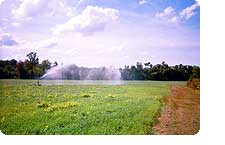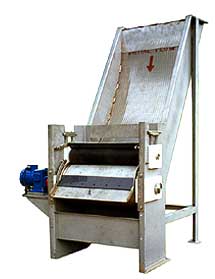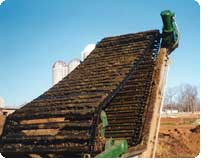 MS-Word Doc: Anaerobic Treatment of Swine and Dairy Waste
Pork and Dairy production wastewater contains high levels of organic
contamination, both soluble and insoluble residues, and urea. The
wastewater has been drained and stored in large foul smelling anaerobic
lagoons containing essentially all of the organic solids and the
nitrogen compounds resulting from the urine waste. The anaerobic
degradation of the solids creates highly undesirable odors and high
levels of nitrogen and nitrogen compounds, which, when distributed over
cropland, easily over-nitrify the soil.
Odor
 Every
farm that produces animals must have a tank to store excess water
resulting from animal excretion, barn flushing and cleaning and
rainwater. Current practice is to store the excess water with the
animal waste in an open earthen basin tank that becomes an anaerobic
lagoon. When the lagoon is full the excess water is pumped to spray
fields and disperse through spray nozzles. The foul smelling gases
resulting from the anaerobic microbial action on the stored animal
waste is liberated. The airborne foul odor drifts along the ground for
miles. The local neighbors are very unhappy and have recently become
irate, with this current practice. Excess Nutrients
If more nutrients (nitrogen) are added
to the soil than is consumed by the crops grown, the excess nitrogen
will either run-off into the river and streams or percolate into the
groundwater. Both results are illegal. Regulatory limits have been
placed on the distribution of nitrogen and its compounds relative to
the consumption of the cultivated crops.
Under current practices, the large dairy and pork production facilities
do not have sufficient land to distribute their collected waste in an
agronomically and environmentally sound manner. Excess nitrogen must
therefore be removed prior to land application.
 Hoffland
Environmental, Inc. has developed economical solutions for concentrated
animal feed operations (CAFO). The methods can be divided into two
different solutions depending upon the size of the operation and
climatic conditions. The first method is the HEI Aerobic System, which
economically removes the solids from the waste, and maintains aerobic
conditions to eliminate the formation of foul odors. An attached
diagram details this method. A discussion of benefits follows. The second method is the HEI Anaerobic System, which collects and
contains the waste animal solids in a covered anaerobic digestion
basin. By heating and inoculation, an environment is created that
permits the microbial culture to rapidly digest the waste solids and
produce methane gas as a by-product. The methane gas produced is
utilized as an energy source to operate a generator and produce
electricity. Thus, the farmer has created a renewable energy resource
from an undesirable waste product. The system will produce more
electricity then the farm consumes. The excess electricity is sold to
the power grid. The remaining liquid after digestion is further treated
under aerobic conditions to degrade the remaining low-level waste. A
diagram of the systems as well as a discussion of the system merit is
following. Aerobic Solution for Dairy and Swine Waste
- Odor Free Spray Fields
- Odor Free Flush Water
- Denitrification of Ammonia
Hoffland Environmental has developed an economical solution for the
pork and dairy producers. HEI will convert your existing lagoon into an
efficient bio-digester. First, to limit the biological load on the
system, the large solids, feces and undigested food are screened from
the wastewater.
HEI's efficient screening and clarification systems removes over 80%
of the total solids. The lagoon environment will be customized to
create areas that develop specific microbial cultures, which digest the
remaining fecal and urine matter, and not only remove the ammonia but
also nitrogen. The treated water will be essentially free of odor,
ammonia and pathogens such as salmonella.
Problem 1: Odor - Eliminated
The entire system supplied
by HEI is free of the traditional anaerobic odor. The screened solids
are collected and stored under aerobic conditions and do not have a
foul odor. When the excess water is spray irrigated, no odor is present. Problem 2: Excess Nitrogen - Eliminated
The biological process (patented by HEI) not only removes the animal
waste but also biologically removes ammonia and nitrogen. The excess
water can be utilized for irrigation through fixed irrigation nozzles.
Foul smelling spray fields do not exist.
|
|
Contaminants |
Flushed Wastewater |
After Solids Separation |
After Biological Treatment |
% Removal |
|
COD |
20,000-50,000 mg/l |
1000-2000 mg/l |
100-500 mg/l |
99% |
|
Nitrogen
(N-NH3) |
500-1000 mg/l |
400-600 mg/l |
10-40 mg/l |
98% |
|
- No Anaerobic Lagoons.
- Reduction of Land Area.
Purchase or lease of additional land to distribute the stored wastewater is not required.
- Expansion
Increase production capacity and profits without increasing the existing storage basin.
- Eliminate Odor
Eliminates spraying of anaerobic waste.
- Irrigation Equipment
With the reduced land area, irrigation equipment may be permanently installed.
The labor required to move and monitor the irrigation reels will be eliminated.
- No Chemicals
Hoffland Environmental has installed its new technology on a North
Carolina Pork Production facility. The unit is a 5000-head farrow to
wein facility with an animal mass of 2000 animal units. The facility
operates with less than 30 kilowatts of electrical energy.
The net operating cost to the producer is about $0.10 - $0.15
per-weiner pig sold. Translating the technology to a finishing
facility, the energy cost would be approximately $0.30 - $0.50 per
finisher produced.
Anaerobic Treatment of Swine & Dairy Waste |
- Reduction of Solids Handling
- Odor Free Environment
- Odor Free Flush Water
- Denitrification of Ammonia
Hoffland Environmental, Inc. has developed an efficient, economical
covered anaerobic system that not only digests the waste animal solids
but also produces sufficient electrical energy to provide a positive
payback for the farmer. The waste animal solids are utilized as a
renewable energy resource (certain tax credits are available for this
type of equipment). The waste solids (reference following diagram)
flushed from the production floors are concentrated and transferred to
a covered mesophilic (temperature 90-100°F) anaerobic digestion basin.
The waste solids in the absence of oxygen and cultured under controlled
mesophilic conditions, will biologically decompose forming biogas
-principally methane gas. The methane is collected, pressurized and
used as fuel for an engine/generator to produce electricity. The
electricity produced will be adequate to supply all of the electric
requirements for the farm plus sell the excess to the power grid. The
amount of electricity produced is proportional to the farms animal
population, typically.
|
5000 Head - Finishers |
— |
50 KW Continuously |
|
1000 Head - Sow - Farrow to Finish |
— |
100 KW Continuously |
|
The waste heat produced by the engine is captured and utilized to
heat the digester basin to maintain the desired mesophilic microbial
growth. Rapid decomposition of the waste solids occurs in a mesophilic
culture. The size of the anaerobic basin is minimal requiring only 10
days retention, usually sized at 20 days for redundancy.
The effluent from the mesophilic digester is transferred to an
aerobic basin to remove the remaining organic components and
biologically remove the ammonia. The ammonia is biologically nitrified
and subsequently denitrified to non-toxic benign nitrogen gas (process
patented by HEI).
The effluent from the aerobic basin is stored for reuse or
distributed through spray fields without the characteristic anaerobic
odor.
Benefits
- Anaerobic odor free operation
- Anaerobic odor free spray fields
- Excess nitrogen nutrients are removed
- No chemicals required
- Sufficient electricity is produced for net payback of equipment
Typical Operating Cost
|
Sow Operation |
— |
(Positive payback from electricity produced, zero electricity bill) |
|
Finisher Operation |
— |
(Positive payback from electricity produced, zero electricity bill) |
|
Typical Treatment
|
|
Treatment Influent |
Treatment Effluent |
Reduction |
|
Organic Matter |
20,000 mg/l |
250 mg/l |
99% |
|
Nitrogen |
600 mg/l |
25 mg/l |
97% |
|
Hoffland Environmental, Inc. will supply either the Aerobic or the
Anaerobic system. The following is a brief comparison of the two
processes.
|
|
Aerobic |
Anaerobic |
|
Capital Cost |
Low Capital Cost |
|
|
Operating Cost |
|
Low Operating Cost |
|
Tax Credits |
|
Available |
|
Ammonia |
Nitrogen Concentration Reduced |
Nitrogen Concentration Reduced |
|
Electricity |
Consumes |
Produces |
|
Waste Solids |
Solids produced must be stored or distributed daily |
Solids flow directly to the digester, no daily labor required |
|
Approximate Cost Excluding Earthwork & Installation |
5000 Head Finishing Facility
|
|
Aerobic |
Anaerobic |
|
Energy Cost |
$5,000/year |
Net pay back possible $20,000/year |
|
15000 Head Finisher or 5000 Sow Facility
|
|
Aerobic |
Anaerobic |
|
Energy Cost |
$15,000/year |
Net pay back possibly $60,000/year |
|
|
 MS-Word Doc: Anaerobic Treatment of Swine and Dairy Waste
MS-Word Doc: Anaerobic Treatment of Swine and Dairy Waste


 Every
farm that produces animals must have a tank to store excess water
resulting from animal excretion, barn flushing and cleaning and
rainwater. Current practice is to store the excess water with the
animal waste in an open earthen basin tank that becomes an anaerobic
lagoon. When the lagoon is full the excess water is pumped to spray
fields and disperse through spray nozzles. The foul smelling gases
resulting from the anaerobic microbial action on the stored animal
waste is liberated. The airborne foul odor drifts along the ground for
miles. The local neighbors are very unhappy and have recently become
irate, with this current practice.
Every
farm that produces animals must have a tank to store excess water
resulting from animal excretion, barn flushing and cleaning and
rainwater. Current practice is to store the excess water with the
animal waste in an open earthen basin tank that becomes an anaerobic
lagoon. When the lagoon is full the excess water is pumped to spray
fields and disperse through spray nozzles. The foul smelling gases
resulting from the anaerobic microbial action on the stored animal
waste is liberated. The airborne foul odor drifts along the ground for
miles. The local neighbors are very unhappy and have recently become
irate, with this current practice.  Hoffland
Environmental, Inc. has developed economical solutions for concentrated
animal feed operations (CAFO). The methods can be divided into two
different solutions depending upon the size of the operation and
climatic conditions. The first method is the HEI Aerobic System, which
economically removes the solids from the waste, and maintains aerobic
conditions to eliminate the formation of foul odors. An attached
diagram details this method. A discussion of benefits follows.
Hoffland
Environmental, Inc. has developed economical solutions for concentrated
animal feed operations (CAFO). The methods can be divided into two
different solutions depending upon the size of the operation and
climatic conditions. The first method is the HEI Aerobic System, which
economically removes the solids from the waste, and maintains aerobic
conditions to eliminate the formation of foul odors. An attached
diagram details this method. A discussion of benefits follows. 